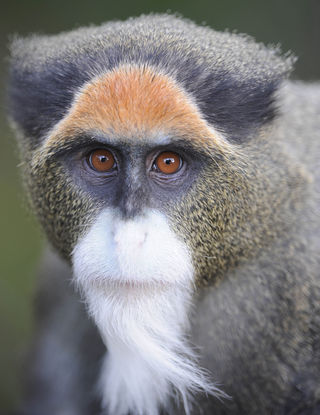Evolutionary Psychology
The Hipster, the Bearded Ape, and God
The evolutionary psychology of beards in apes, men, and God
Posted February 11, 2015

Facial hair on men comes in and out of vogue, and at the time that this article was written the popularity of beards has been on the rise for nearly a decade. It has become increasingly common to see unshorn men among not only the usual wearers of facial shag—the bikers, the lumberjack-types—but among fashion models, Hollywood stars, and everyday guys. Surely the popularity of beards will continue to ebb and flow, with the frivolity of every other kind of fashion statement in the Western world. However, the evolutionary history of beards reveals a far more serious purpose than mere facial accessorizing. The allure of beards is rooted in the violent past of male mate competition.
In the natural world, it pays to be bigger. Many animals possess adaptations that feign larger size to intimidate rival males (or predators), and most appear on the head where there is attentional bias—it’s important to focus on where the teeth and the windows of intention are. The frillneck lizard is a perfect example. It looks fairly common. But when threatened it deploys large skin flaps on the sides of its head, making its face look bigger and more menacing. Male lions have spectacular manes, which serve a similar purpose. The lion’s mane makes his head look bigger, and research finds that longer-maned lions are more successful fighters. The elephant’s flaring ears, the cobra’s hood—there a great many threat displays in the natural world that aim to make the head look bigger. A number of non-human male primates have mustaches, ear tufts, and beards, but none as spectacular as the male orangutan. Not only does he have a long orange beard and moustache, but also large fatty check pads, and a wide flaring “zygomatic” bone from the sides of his head to his upper jaws. This makes his face look huge in comparison to females and adolescents, both of which he dominates.
Now, most hipsters and other bearded types walk about sporting their facial coiffures unaware of their evolved purpose. But as primates, men share certain adapted functions with their orange-bearded cousins. In 1976, paleobiologist R. Dale Guthrie noted that men’s beards appear to extend the edge of the chin and exaggerate head size, which likely served to intimidate rivals. This sly purpose is thrown into relief by the fact that men also exaggerate head size artificially through big head gear, from the buffalo headdress of the Plains Indian warriors to the campaign-pin-festooned hats of generals to the jeweled crowns of kings. Such displays are specifically designed to engender terror, signify experience fighting, and/or demonstrate high rank.
When the topic is brought to the research lab, it becomes clear that the psychological intrigue of beards is more enduring than the fashion trends that showcase them. In a classic 1973 study, psychologist Robert Pellegrini found that subjects rating pictures of men perceived more facial hair to indicate greater dominance, masculinity, self-confidence and strength, among other virile traits, leading him to conclude, “…the male beard communicates a heroic image of independent, sturdy, and resourceful pioneer, ready, willing and able to do manly things.” A number of other studies find that subjects rate men with beards as more aggressive, stronger, more dominant, and having higher social status. Tying to the ageless competition for mates, one study found that the tendency to rate bearded men as masculine intensified among women in their fertile phase, and that women rated fully bearded men as making better fathers. It’s worth mentioning that the male hormone testosterone drives beard growth in men, the same chemical responsible for aggression and sex drive.
As I explain in my forthcoming book Alpha God, religions bear all the marks of primate dominance, to include large head displays. The pope’s papal tiara, for example, is a towering, triple-crown of gold and sparking gems explicitly meant to signify that the pope’s rule transcends the civil authorities. Historically, popes have literally had the power to make kings kiss their feet. Here are the words traditionally spoken at the papal coronatio, “Receive the tiara adorned with three crowns and know that thou art the father of princes and kings, ruler of the world…”
As for beards, those naturally occurring head-enlargers inherited from our primate ancestors, the Old Testament orders that “You shall not round off the side-growth of your heads nor harm the edges of your beard” (Lev. 19:27). Many religious men are required to wear them, including in Hinduism, Rastafarianism, Judaism, Sikhism, and among the Amish. Ancient Egyptian Pharaohs, who were considered gods on earth—the absolute pinnacle of male human power— wore exaggeratedly long false beards called postiches as a symbol of their divine status. Saint Clement of Alexandria astutely noted the parallels between men’s beards (and chest fuzz) and the fearsome head displays of male lions, claiming that God “adorned man, like the lions, with a beard, and endowed him, as an attribute of manhood, with shaggy breasts—a sign of strength and rule”. And religious beards still resonate as symbols of competition and power. Amish men in Ohio have recently been arrested for assaulting their male co-worshippers and chopping off their beards. Similarly, when videos emerged of Saddam Hussein, captured and having his beard checked for lice, it enraged the Ba’athist, Sunni, and other Islamists for whom touching a man’s beard is considered a terrible insult. Finally, in American popular culture, God, the most dominant male in the Universe—whose archetype I argue is based on a dominant male human— is sometimes called the bearded old man. For us primates and our evolved minds, bound as we are to our competitive and reproductive urges, this implies a different level of dominance from, say, a smooth-faced adolescent.
In general, the older an adaptation is, the deeper its psychological meaning may be embedded in our thinking, and often below conscious awareness. And so, until pressed with clever questions in a research lab, many of us have psychological, and even endocrinological, reactions to things without even realizing it. So even the most civilized, peaceable, unassuming bearded hipster may pull for reactions that trace back to a time during which our male primate ancestors were battling to survive and reproduce. Doubly so for men of the cloth representing that ever-dominant male in the sky.


